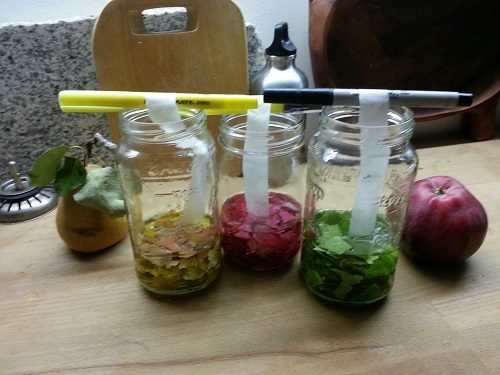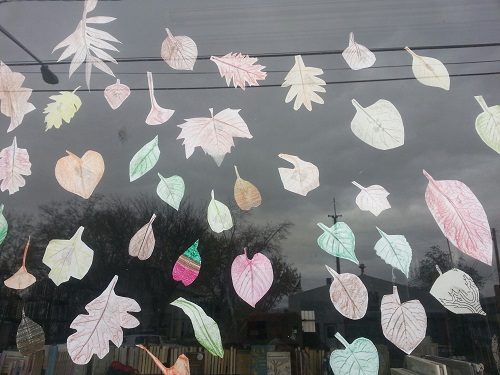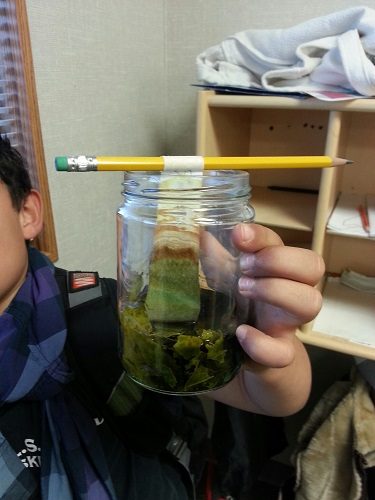Did you know that there are both visible and invisible changes happening in each leaf as they change colors in the fall?
 As a former California PLT State Coordinator, I am finding many fun opportunities in my retirement to help kids discover answers to questions like this using PLT. In my role as “Science Nanny” for the afterschool program at Surprise Valley Elementary School in Modoc County, California, PLT is helping me incorporate environmental education and experiential learning to increase student interest, confidence, and knowledge in science.
As a former California PLT State Coordinator, I am finding many fun opportunities in my retirement to help kids discover answers to questions like this using PLT. In my role as “Science Nanny” for the afterschool program at Surprise Valley Elementary School in Modoc County, California, PLT is helping me incorporate environmental education and experiential learning to increase student interest, confidence, and knowledge in science.
We used PLT’s Signs of Fall activity, found in PLT’s PreK-8 Environmental Education Activity Guide and PLT’s Explore Your Environment: K-8 Activity Guide, to teach students about fall colors and the signs of fall they observe each year. In this activity, students discovered visible and invisible changes in autumn leaves, observed the annual change of seasons, and investigated why leaves of deciduous trees change color. Together my students and I had a lot of fun learning what makes trees so colorful.
Visible Changes
All around us, tree leaves are changing. Vibrant shades of reds, yellows, and oranges are great visual indicators that fall is here.
 I shared these changes with the afterschool kids, and they discussed seasonal changes they have seen. Due to time and daylight limitations, I brought nature indoors, sharing leaves that I found at home. (If time allows, I’d recommend you take students outside to look for leaves and other signs of fall. Wooded areas, school yards, parks, neighborhoods, even your own backyard are all great places to search.)
I shared these changes with the afterschool kids, and they discussed seasonal changes they have seen. Due to time and daylight limitations, I brought nature indoors, sharing leaves that I found at home. (If time allows, I’d recommend you take students outside to look for leaves and other signs of fall. Wooded areas, school yards, parks, neighborhoods, even your own backyard are all great places to search.)
I asked students to make rubbings of our fall leaf collection using crayons and paper. Students made impressions of the leaves, cut them out, and later we taped them to the town’s library window for everyone to see.
Invisible Changes
Although a leaf may appear to be one color, it actually contains pigments of multiple colors. In the summer, chlorophyll, the green pigment, dominates, concealing others. As chlorophyll breaks down in the fall, other pigments reveal themselves or form, turning the leaves yellow, orange, or red. I led the afterschool students through a chromatography experiment to identify what colors were hiding inside the leaves.
 Students first crunched up the leaves and put them in glass jars, using one jar for each leaf color. I then covered the leaves with rubbing alcohol. Next we placed strips of coffee filter paper into the colorful liquid in each jar. After a while, the paper absorbed some of the liquid and we could see streaks and bands of color on each of the paper strips.
Students first crunched up the leaves and put them in glass jars, using one jar for each leaf color. I then covered the leaves with rubbing alcohol. Next we placed strips of coffee filter paper into the colorful liquid in each jar. After a while, the paper absorbed some of the liquid and we could see streaks and bands of color on each of the paper strips.
We successfully extracted red, yellow, and green pigments from the leaves! Because the color of each leaf is determined by a combination of the pigments inside, each paper strip had bands of colors in different sizes.
Watch this video demonstration created by North Carolina PLT Coordinator Renee Strnad for step-by-step instructions for doing this activity.
Following the activity, one of my students asked, “What would happen if we took a green leaf and painted it yellow?” We may have to try that experiment next time so he can discover the answer. What do you think would happen?
Resources
- Login to access resources for PLT’s Signs of Fall activity, including downloadable Student Pages (in English and Spanish).
- Check out this video Why Do Autumn Leaves Change Color? from Scientific American. It’s a nice, succinct explanation about how leaves on deciduous trees change color.
- Download this free PLT Family Activity that can be easily done at home to encourage children to go outside and look for signs of autumn.


